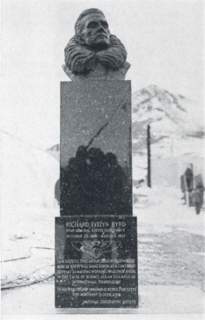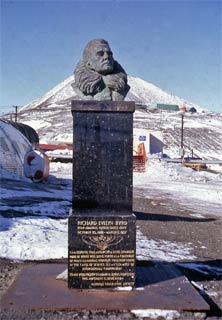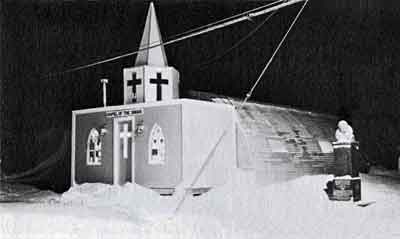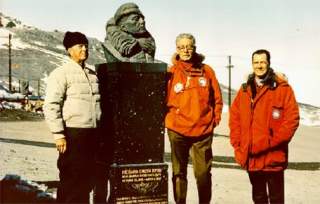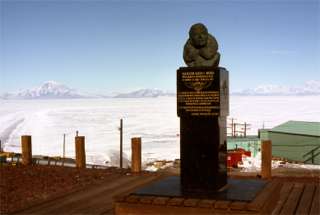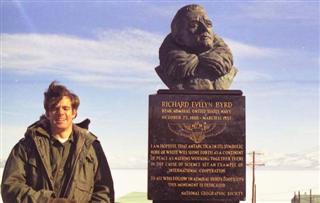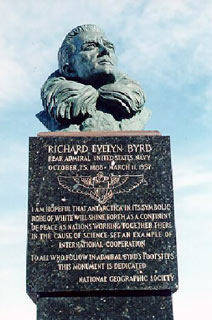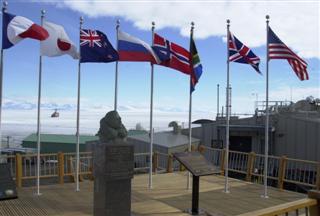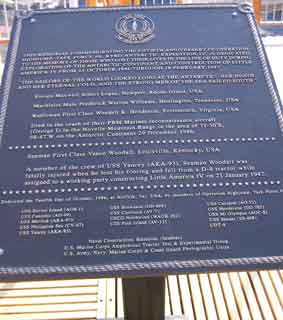The Byrd Memorial at McMurdo
|
What are we looking at? The photo at left was taken at the dedication of the memorial on 25 October 1965 at the original site next to the chapel, with Byrd facing the main part of town. The right photo from November 1977 was taken at the more recent site in front of the Chalet. Somehow at some point the marble pedestal got rearranged...more than once! [photo credits at bottom of this page] Below is a photo of the statue a year after the dedication...and clearly visible is an additional band of roughened marble just below the bust: At right below is another view of the original site in July 1967, along with the text of the dedication article from the January/February 1966 Antarctic Journal:
Memorial to Byrd DedicatedA memorial to the late Rear Admiral Richard E. Byrd was dedicated at McMurdo Station on October 25, 1965, the anniversary of his birthday. The bronze bust of the famed explorer rests atop a polished Norwegian black marble pedestal which has inscribed on its sides the more significant achievements and the dates of his five Antarctic expeditions. Inscribed on the base of the monument are Admiral Byrd's own words: I am hopeful that Antarctica in its symbolic robe of white will shine forth as a continent of peace as nations working together there in the cause of science set an example of international cooperation. Sculptor of the monument was Mr. Felix de Weldon, who is noted for his famous Iwo Jima war memorial in Arlington, Virginia. The McMurdo statue is a replica of the memorial to Admiral Byrd which stands on the "Avenue of Heroes" in Washington, D.C. This memorial was dedicated by the then Vice President Lyndon B. Johnson. Both Byrd memorials were donated by the National Geographic Society. In addition to the works listed above, and a later duplicate bust in Dunedin, Felix also did Elvis; in any case he is probably the only artist with works on display on all 7 continents. Felix de Weldon died in June 2003 at 96. The monument would remain at this location and in this configuration until 1972-73, as documented by the next two photos: | |||||
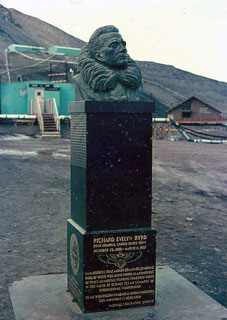 This photo on a warmer day in 1971-72 shows the inscribed portion of the pedestal still on the bottom, apparently resting on a steel plate. | |||||
|
Early in the 1972-73 season, the original "International Square" was constructed in front of the Chalet. This provided a more prominent setting for Admiral Byrd, surrounded by flags of the Antarctic Treaty nations. At left below is the setting in December 1972; the inscribed portion of the pedestal has been moved to the top. What can't easily be discerned from this graphic (but is clearly visible in the original slide) is the fact that the Admiral is facing toward the South Pole. The view at right is the same setting in November 1977, when Byrd was facing the North Pole... hmmm. Of course the Treaty flags were only flown for special occasions and I didn't have my camera with me at the right times... | |||||
|
Actually during much of this time period the pedestal was not attached to the base, so after a few warm sunny days the marble would warm up enough to melt the ice underneath it, and this made it fairly easy to move and rotate. A bit heavy, however, for the trip to Scott Base (?!) at least from what I've been told. Below are two more photos--the one at left from 1973-74 features Robert Byrd Breyer, Admiral Byrd's grandson, who worked for Holmes and Narver as a field engineer at the domed station construction. At right is a closeup from the mid 90's. | |||||
|
The memorial was moved elsewhere while the Crary Lab was built; afterwards
Here are closer looks at the flanking plaques: Photo credits: 1965-66 photo from the Antarctic Journal, January/February 1966; 1975 photo from Support for Science, Antarctica, US Naval Support Force, Antarctica, fourth edition, February 1968; 1969-70 photo from the Carleton College library; 1971-72 photo by Don Leger; 1972-73,1977-78 and 2005 photos by Bill Spindler; 1973-74 photo by Patrick Blaylock; mid-90's photo by Joe Hawkins; winter 2000 photo by Jim Pasola; 2004 photo by Brien Barnett, NSF (USAP photo library). | |||||
